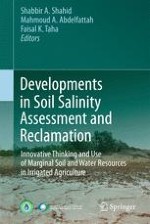2013 | Buch
Developments in Soil Salinity Assessment and Reclamation
Innovative Thinking and Use of Marginal Soil and Water Resources in Irrigated Agriculture
herausgegeben von: Shabbir A. Shahid, Mahmoud A. Abdelfattah, Faisal K. Taha
Verlag: Springer Netherlands
